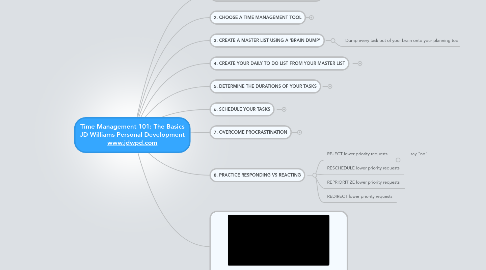Time Management 101: The Basics JD Williams Personal Development www.jdwpd.com
por Jonathan Williams


1. 1. DIAGNOSE YOUR TIME MANAGEMENT HABITS
1.1. Do you have a main planning tool?
1.2. Do you have all tasks listed in one place?
1.3. Do you use a daily to-do list?
1.4. Do you determine task lengths?
1.5. Do you schedule your tasks?
1.6. Do you avoid time wasting distractions?
1.6.1. Reacting instead of Responding
1.6.1.1. Time Wasters
1.6.1.1.1. goofing off
1.6.1.1.2. long winded
1.6.1.1.3. tracking down
1.6.1.1.4. overdoing things
1.6.1.1.5. handling excessive paperwork
1.6.1.1.6. technology
1.6.1.1.7. fixing miscommunications
1.6.1.1.8. inefficient meetings
1.6.1.1.9. interruptions
1.6.2. Bouncing from task to task
1.6.3. Procrastinating
2. 2. CHOOSE A TIME MANAGEMENT TOOL
2.1. Electronic Planning Tools
2.1.1. Desktop
2.1.2. Laptop
2.1.3. Tablet
2.1.4. Smartphone
2.2. Paper Planning Tools
2.2.1. Franklin Covey Planner
2.2.2. Spiral Notebook
2.2.3. Legal Pad
3. 3. CREATE A MASTER LIST USING A 'BRAIN DUMP'
3.1. Dump every task out of your brain onto your planning tool
4. 4. CREATE YOUR DAILY TO DO LIST FROM YOUR MASTER LIST
4.1. A's
4.1.1. 'A'bsolutely must do today
4.2. B's
4.2.1. 'B'eneficial to do today
4.3. C's
4.3.1. 'C'ould do today
4.4. D's
4.4.1. 'D'on't do today or Delegate
5. 5. DETERMINE THE DURATIONS OF YOUR TASKS
5.1. Determine how long each task should take
6. 6. SCHEDULE YOUR TASKS
6.1. Determine in which block of time you will complete it
7. 7. OVERCOME PROCRASTINATION
7.1. Consistently schedule tasks
7.2. Break big tasks into smaller work chunks
7.3. Break big tasks into smaller time chunks
7.4. Launch your plan
7.5. Have someone hold you accountable
8. 8. PRACTICE RESPONDING VS REACTING
8.1. REJECT lower priority requests
8.1.1. say "no"

